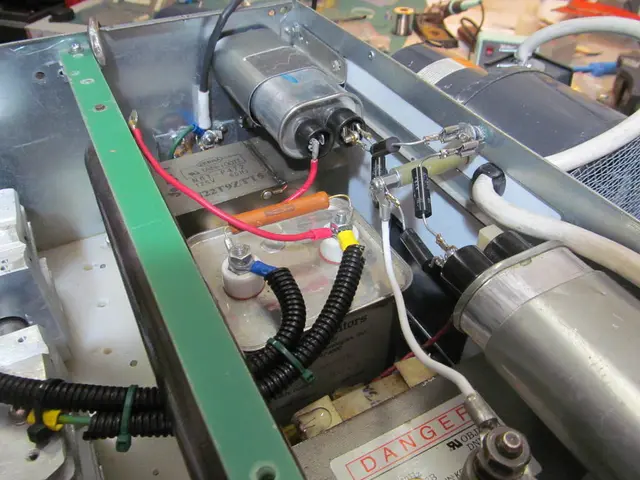Brr, It's Freezing on the Moon: NASA's New Spacesuits Must Keep Lunar Explorers Warm
NASA Requires Lunar-Resistant Gloves and Footwear to Endure Extreme Lunar Cold
NASA's’ upcoming adventures to the Moon's chilly southern pole are shaping up to be a real blast—in more ways than one! The space agency is battling the cold to keep their astronauts cozy when roaming the permanently shadowed regions of the lunar south pole.
A team of NASA whizzes is fine-tuning elbow joints in a gargantuan cryogenic chamber, scrutinizing the fabric of the next-gen spacesuits destined for Moon duty. Known as the Cryogenic Ice Testing, Acquisition Development, and Excavation Laboratory, or CITADEL for short, this baby was initially designed to test robot parts for unmanned missions bound for the icy moons of our solar system. But with humanity's long-awaited return to the Moon on the horizon, CITADEL is having its moment in the (cold) limelight.
"We're eager to understand the risks our astronauts face when venturing into permanently shadowed areas, and gloves and boots are super important because they come in contact with freezing surfaces and tools for extended periods," explains Zach Fester, NASA's Advanced Suit Team tech lead at Johnson Space Center.
Measuring a colossal 4 feet (1.2 meters) tall and 5 feet (1.5 meters) wide, CITADEL is stationed at NASA's Jet Propulsion Laboratory. Most cryogenic facilities rely on liquid nitrogen to chill objects, but CITADEL uses compressed helium to reach bone-chilling temperatures around -370 Fahrenheit (-223 Celsius). It takes days to reach these deep-freeze temperatures, and popping it open kicks off the whole cooling process from scratch. To avoid wasting precious time, CITADEL is equipped with four load locks, which are like drawers that maintain the chamber's frigid, vacuum state while allowing test materials to be inserted.
CITADEL also boasts a robotic arm to snag test materials and cameras capturing visible and infrared light to document the testing process. For simulations of Moon missions, the team adds abrasion testing and lunar regolith-like materials to the chamber, alongside aluminum blocks simulating tools that astronauts may grab.
In the past, NASA would tuck its actual astronauts into icy glove boxes for thermal testing, making them touch frosty objects and endure plummeting skin temperatures down to 50 degrees Fahrenheit (10 degrees Celsius). Now, NASA employs a custom-built manikin hand and foot for testing inside CITADEL. The manikin's extremities are kitted out with a fluid loop system mimicking warm blood flow and brimming with temperature and heat flux sensors to snag data from inside the gloves and boots.
NASA's Artemis 3 mission is all set to bring astronauts back to the lunar surface for the first time since the Apollo era. Unlike the Apollo astronauts landing near the Moon's equator on the near side, the Artemis crew will be exploring the lunar south pole. The moon's south pole may harbor water ice in permanently shadowed regions, but it's an icy, inhospitable landscape due to extreme temperatures and areas devoid of sunlight. The Artemis astronauts will spend roughly two hours at a time inside craters potentially filled with ice deposits, temperatures plummeting to a frigid -414 degrees Fahrenheit (-248 degrees Celsius).
The future Moon-walkers will don sleek, new spacesuits. In 2022, NASA enlisted Axiom Space to design the first lunar-traversing spacesuits since the Apollo missions. The result: the AxEMU, or Axiom Extravehicular Mobility Unit, built on the legacy of the Apollo suits and incorporating modern tech for enhanced mobility and protection against the lunar environment. Axiom Space even collaborated with fashion powerhouse Prada to offer design and material expertise, while keeping an eye on aesthetics for the Moon-bound astronauts.
The tests in CITADEL will help NASA establish guidelines for its futuristic AxEMU spacesuits. The gloves presently being examined in the chamber represent the sixth iteration of a glove NASA has been using since the 1980s, featured on the International Space Station for spacewalks. Regrettably, these gloves haven't performed well in CITADEL, lagging behind the thermal demands of the lunar south pole. The results from the boot testing are still being analyzed.
"This trial aims to identify the limits: How long can this glove or boot withstand the lunar environment? We want to quantify the gap in our current hardware's capabilities so we can convey that info to the Artemis suit vendor, and we're also developing this unique test capability for future hardware designs," Shane McFarland, tech development lead for the Advanced Suit Team at NASA Johnson, explains.
NASA's Artemis 3 mission is slated to launch in 2027, sending astronauts on an expedition to uncharted territories on the Moon. Hopefully, the astronauts can stay snug and warm during their chilly excursion into the lunar south pole.
- NASA's Advanced Suit Team is fine-tuning the next-generation spacesuits, known as AxEMU, for the Artemis 3 mission, a collaboration with Axiom Space that aims to send astronauts back to the lunar surface for the first time since the Apollo era.
- The Cryogenic Ice Testing, Acquisition Development, and Excavation Laboratory (CITADEL) is being used to test the thermal performance of the gloves and boots for the AxEMU spacesuits, simulating the icy and inhospitable landscape of the Moon's south pole.
- The upcoming Artemis 3 mission will explore the lunar south pole, which may harbor water ice in permanently shadowed regions, but features extreme temperatures and areas devoid of sunlight, reaching as low as -414 degrees Fahrenheit (-248 degrees Celsius).
- The tests in CITADEL are crucial for identifying the limits of the current gloves and boots, as they need to withstand the harsh lunar environment for extended periods, ensuring the comfort and safety of the future Moon-walkers during their exploration of space and the Moon.




